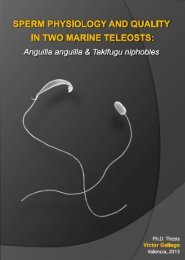8 - RiuNet - UPV
8 - RiuNet - UPV
8 - RiuNet - UPV
Create successful ePaper yourself
Turn your PDF publications into a flip-book with our unique Google optimized e-Paper software.
8 th International Symposium on Fruit Flies of Economic Importance. Valencia 2010.<br />
OVIPOSITION CHOICE OF BACTROCERA PAPAYAE DREW & HANCOCK (DIPTERA:<br />
TEPHRITIDAE): FULLY-RIPE FRUIT OR UNRIPE FRUIT WITH WOUND ON FRUIT<br />
SURFACE.<br />
Rattanapun, Wigunda* 1 & Amornsak, Weerawan 2<br />
1 Department of Agricultural Technology, Faculty of Technology and Community Development, Thaksin<br />
University, Phatthalung, 93110 Thailand. Email: rwigunda@tsu.ac.th; 2 Department of Entomology, Faculty of<br />
Agriculture, Kasetsart University, Bangkhen Campus, Chatuchak, Bangkok, 10900 Thailand.<br />
Background: The oviposition preference of many species of tephritid fruit fly relies on fruit<br />
firmness. To minimise aculeus wear, female tephritid flies are thought to prefer to oviposit in<br />
fruit wounds or softer exopericarp of ripe and fully-ripe fruits over harder exopericarp of<br />
unripe fruit. The fully-ripe fruit was suitable for larval growth and preferred for oviposition by<br />
female fly of Bactrocera dorsalis (Hendel) (Diptera: Tephritidae) more than unripe fruit, soft<br />
exocarp of fully-ripe fruit appeared to be the limiting factor of oviposition, with few successful<br />
ovipositions recorded in all studies, and very few in unripe fruit. In this study, we asked<br />
whether female flies that were exposed to both fully-ripe fruit without wound and unripe fruit<br />
with wound on fruit surface, would choose fully-ripe fruit for oviposition or not. The result of<br />
this study can enhance our understanding of host utilization by female fly.<br />
Methods: A choice experiment was conducted to determine the behavior of individual female<br />
Bactrocera papayae Drew & Hancock (Diptera: Tephritidae). Both fully-ripe mango without<br />
wound and unripe mango with wound on fruit surface of mango, Mangifera indica,<br />
Namdorkmai varity (Anacardiaceae) were offered simultaneously in a 30×30×30 cm<br />
observation cage. An individual, 21–22-day-old, mated female fly was released in an<br />
observation cage. Fruit fly behaviors observed and recorded were: (i) duration of fly visits to a<br />
fruit, (ii) number of attempted ovipositions (unsuccessful penetration), and (iii) duration of<br />
successful oviposition events. Observations were done from 09:00–15:00 hours. Twenty<br />
single-fly replicates were conducted. At the end of the day, female flies were dissected to<br />
check whether eggs were presented in their ovaries. All fruits that female flies had laid eggs<br />
into were dissected for number of egg count.<br />
Results: The total duration of visits differed significantly between the stages of ripening (t-test:<br />
t = 15.010, d.f. = 38, P < 0.0001), with unripe fruits being visited in longer and fully-ripe fruit<br />
significantly less. There were also significant differences in the number of attempted<br />
ovipositions between the various fruit ripening stages, with fewer attempted ovipositions into<br />
fully-ripe fruit and higher penetration into unripe fruit (t-test: t = 6.696, d.f. = 38, P < 0.0001).<br />
All female flies could not oviposit into full-ripe fruits. The average time of successfully<br />
oviposition duration into wound on unripe fruit of female flies is 35.05 ± 1.52 minutes.<br />
Conclusions: The results of this study indicated that fruit wound play an important role in the<br />
oviposition determination of female fly B. papayae. Female B. papayae chose unsuitable host<br />
that she could easier oviposit than nutritious host which was hard to oviposit. Thus, it is<br />
difficult to assume that oviposition preference of female flies relates solely to the performance<br />
of their larvae.<br />
Keywords: Bactrocera papayae, oviposition preference, mango, ripening.

















